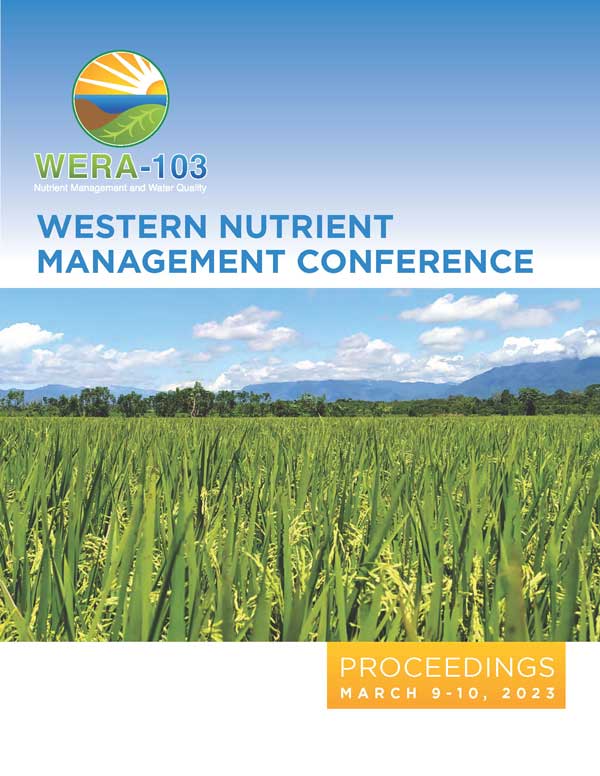Download the Conference Proceedings
Proceedings
Authors
| Filter results8 paper(s) found. |
|---|
1. Precision Sensing for Improved Wheat ProductionImproving nitrogen (N) use efficiency (NUE) from current 35-40% is important for growers’ sustainability and environmental quality. Unmanned Aerial Vehicles (UAVs) are proposed as an alternative to traditional field scouting for making crop management decisions. Precision sensors and cameras mounted on the UAVs provide high quality images which can be used to make fertilizer recommendations in-season based on crop nutrient status. A study was conducted at 5 locations in Southern Idaho in... O. Walsh, J. Marshall, J. Mcclintick-chess, S. Blanscet, C. Jackson |
2. Plant Available Silicon Application in Winter WheatMany studies throughout the world has shown that various crops have positively responded to silicon (Si) application in terms of plant health, nutrient uptake, yield, and quality. The study’ objective was to evaluate the effect of Si application rate and time on winter wheat growth and development, grain yield and grain quality. Results suggest that application of plant available silicon at 50% rate at either emergence or Feekes 5 appears to be more advantageous in terms of winter wheat... O. Walsh, J. Mcclintick-chess, S. Blanscet |
3. Response of Spring Wheat to Varied Nitrogen and Water ApplicationsThis study’s objectives were to 1) determine the minimum N and water requirements for optimum wheat grain yield and quality; 2) develop a sensor- based system for identifying – and distinguishing between – N and water stress; 3) produce grower recommendations based on the developed model; and 4) improve grower adoption of efficient water and N application practices and enhance grower understanding of sensor-based technologies. This was the first year of the study, project will... O. Walsh, J. Torrion, X. Liang, J. Mcclintick, S. Blanscet |
4. Sensor-based Technologies for Nitrogen Management in Spring WheatCrop sensor-based systems with developed algorithms for making mid-season fertilizer nitrogen (N) recommendations are commercially available to producers in some parts of the world. Although there is growing interest in these technologies by grain producers in Montana, use is limited by the lack of local research under Montana’s semiarid conditions. A field study was carried out at two locations in 2011, three locations in 2012, and two locations in 2013 in North West Montana. The objectives... O. Walsh, A. Pandey, R. Christiaens |
5. Evaluation of Micro-carbon Technology-based P Fertilizer, Super Phos®, in Spring WheatSuper Phos® (SP; 0-50-0) by Bio Huma Netics Inc. (Gilbert, AZ) is a Micro Carbon TechnologyTM – based phosphorus (P) fertilizer specifically formulated to resist “tie-up” with calcium (Ca) and magnesium (Mg) to remain water soluble and available to plant roots. The objective was to compare the efficiency and effectiveness of topdress and foliar application of SP, with traditional P fertilizers – ammonium polyphosphate (APP; 10-34-0), diammonium phosphate (DAP;... O. Walsh, A. Pandey, R. Christiaens |
6. Environmentally Smart Nitrogen Performance in Northern Great Plains’ Spring Wheat Production SystemsField trials were conducted at three locations in Montana to evaluate the efficacy of Environmentally Smart Nitrogen (ESN) (44-0-0) as a nitrogen (N) source for spring wheat. The ESN, urea (46-0-0), and a 50%-50% urea-ESN blend was applied at seeding at three rate levels - low, medium, and high - with actual rated dependent on the yield goal at each location, followed by urea application of 0 or 40 lb N/a at Feekes 5. Grain yield (GY) varied from 265 to 815 lb/a and grain protein (GP) content... O. Walsh, A. Pandey, R. Christiaens |
7. Liquid N Fertilizer Evaluation in Spring WheatSeveral liquid N products are currently marketed for fertilization in various crops, including spring wheat. Urea ammonium nitrate (UAN) - the most commonly used liquid N fertilizer - is associated with crop damage due to corrosiveness. This study aimed to answer the following questions: (1) Are liquid urea (LU) and High NRG-N (HNRGN) superior to UAN in improving spring wheat grain yield and protein content? And (2) what is the optimum dilution ratio of foliar fertilizers and the threshold at... O. Walsh, A. Pandey, R. Christiaens |
8. Nitrogen Fertilizer Rate and Timing Implications for Malt, Food, and Feed Barley Production in Southern IdahoNitrogen is an essential nutrient required to produce high-yielding barley. Nitrogen strongly impacts barley yield, grain protein, tillering, and lodging potential. Unlike other crops such as corn, available nitrogen must be carefully managed for producers to achieve both optimal yield and grain quality for malt, food, and feed barley. Exessive nitrogen availability increases grain protein concentration that may be unsuitable for malting but may be ideal for feed or food barley. The objective... J. Spackman, O. Walsh, A. Adjesiwor, O. Adeyemi, J. Sagers, R. Findlay, J. Bevan |
